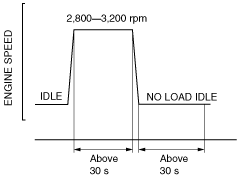 |
OBD DRIVE MODE [L3]
id0102a2815800
PCM Adaptive Memory Procedure Drive Mode
1. Start the engine and warm it up completely.
2. Verify all accessory loads (A/C, headlights, blower fan, rear window defroster) are off.
3. Perform no load racing at the engine speed shown in the graph, then idle the engine for more than 30 s after the cooling fan is stopped. If possible, monitor RPM PID for engine speed and FAN1 PID for cooling fan conditions during this procedure.
atraaw00002064
|
4. Turn ignition switch off then to the ON position again.
5. Access the RFCFLAG PID to confirm the PCM adaptive memory conditions. If the RFCFLAG PID is ON, the PCM adaptive memory procedure drive is completed.
6. If the RFCFLAG PID is still OFF, go back to Step 1.
A/F Sensor Heater, HO2S Heater, A/F Sensor, HO2S, and TWC Repair Verification Drive Mode
1. Access the RFCFLAG PID to confirm PCM adaptive memory condition. If RFCFLAG PID is OFF, perform the PCM adaptive memory procedure drive first.
2. If RFCFLAG PID is ON, start the engine and warm it up completely.
3. Verify all accessory loads (A/C, headlights, blower fan, rear window defroster) are off.
4. Drive the vehicle as shown in the graph; first drive in zone 0, then A or B, followed by C or D, finally E or F. Driving conditions before constant speed driving are not specified.
atraaw00003371
|
|
Zone |
Range/Position |
Vehicle Speed km/h {mph} |
Time (S) |
|---|---|---|---|
|
0
|
P or N
|
0
|
T1: Above 455
|
|
A
|
2
|
40—65 {25—41}
|
T2: Above 30
|
|
B
|
D (O/D OFF switch ON)
|
65—80 {41—49}
|
|
|
C
|
2
|
40—55 {25—34}
|
T3: Above 20
|
|
D
|
D (O/D OFF switch ON)
|
65—80 {41—49}
|
|
|
E
|
D (O/D OFF switch ON)
|
65—80 {41—49}
|
T4: Above 120
|
|
F
|
D
|
70—100 {44—62}
|
5. Stop vehicle and access the ON BOARD SYSTEM READINESS menu of the GENERIC OBD FUNCTION to inspect the drive mode completion condition. If completed, the RFC changes from NO to YES.
6. If not completed, turn the ignition switch off, then go back to Step 4.
7. Access the DIAGNOSTIC MONITORING TEST RESULTS menu of the GENERIC OBD FUNCTIONS to inspect the monitor results. If the MEAS are not within the specification, the repair has not completed.
8. Verify that no DTC is present.